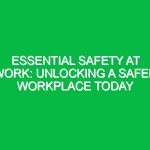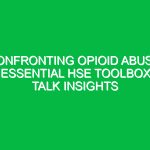Introduction
Assessing critical risks in health, safety, and Environment (HSE) is a fundamental process that protects individuals, communities, and the planet. This involves identifying potential Hazards, evaluating their likelihood and impact, and implementing measures to mitigate risks. The relevance of assessing risks in the HSE domain cannot be overstated; it serves as a foundation for creating safe workplaces, ensuring employee well-being, and fostering sustainable practices that protect our environment. In a world where workplace accidents and environmental disasters can have devastating consequences, understanding how to effectively assess these risks is vital for organizations of all sizes.
The Importance of Assessing Risks in HSE
Risk assessment in HSE is not merely a compliance exercise but a proactive approach to maintaining Safety and Sustainability. By systematically identifying risks, organizations can prioritize their resources and efforts toward the most significant Hazards. This proactive stance not only reduces the likelihood of accidents and environmental damage but also enhances employee morale and company reputation. Furthermore, effective risk assessment can lead to financial savings by minimizing the costs associated with accidents, legal liabilities, and regulatory penalties.
Key Components of Risk Assessment in HSE
Assessing critical risks in the HSE domain involves several key components:
- Hazard Identification: The first step is to identify potential hazards that could cause harm. This includes physical, chemical, biological, ergonomic, and psychosocial hazards.
- Risk Analysis: Once hazards are identified, the next step is to analyze the risks associated with each hazard. This involves evaluating the likelihood of occurrence and the potential severity of outcomes.
- Risk Evaluation: In this phase, organizations determine which risks are acceptable and which require further mitigation measures. This often involves comparing estimated risks against predefined criteria.
- Control Measures: After determining which risks need addressing, organizations implement Control Measures to mitigate these risks. This can include engineering controls, administrative changes, training, and Personal Protective Equipment.
- Monitoring and Review: Finally, it’s essential to continuously monitor and review the effectiveness of risk Control Measures. This ensures that the strategies in place remain relevant and effective over time.
Methodologies for Risk Assessment
Several methodologies can be employed for assessing risks in the HSE context. Some of the most widely recognized methods include:
1. Qualitative Risk Assessment
This approach relies on subjective judgment and expert opinion to identify and evaluate risks. It is often used when quantitative data is scarce. A common tool in qualitative assessments is the risk matrix, which categorizes risks based on their likelihood and severity.
2. Quantitative Risk Assessment
Quantitative assessments use numerical data to evaluate risks, providing a more precise measurement of potential impacts. This method often employs statistical models and historical data to calculate probabilities and consequences, making it suitable for more complex scenarios.
3. Bowtie Analysis
Bowtie analysis combines elements of both qualitative and quantitative assessments. It visually represents the relationship between the causes of a risk event and its consequences, allowing organizations to identify preventive and mitigative controls effectively.
4. Failure Mode and Effects Analysis (FMEA)
FMEA is a systematic method for evaluating processes to identify where and how they might fail and assessing the relative impact of different failures. This technique is particularly useful in manufacturing and engineering settings.
Identifying Hazards and Risks
Effective risk assessment begins with a thorough identification of hazards. Various techniques can be employed to uncover potential risks within an organization:
- Inspections: Regular workplace inspections can help identify existing hazards. This includes evaluating equipment, processes, and the overall work environment.
- Incident Reporting: Analyzing past incidents can provide valuable insights into potential risks. By reviewing what went wrong in previous situations, organizations can identify trends and areas for improvement.
- Employee Feedback: Employees are often the best source of information about potential hazards. Encouraging open communication and feedback can help uncover risks that might not be immediately apparent.
- Job Safety Analysis (JSA): This involves breaking down tasks into steps, identifying hazards at each step, and determining Safe Practices to mitigate those hazards.
Best Practices for Risk Assessment in HSE
To effectively assess and manage risks in the HSE domain, organizations should follow Best Practices:
- Involve Employees: Engage employees at all levels in the risk assessment process. Their firsthand experience can provide valuable insights into potential hazards.
- Regular Training: Continuous training on safety practices and risk assessment methodologies is essential to keep everyone informed and prepared.
- Document Everything: Maintain thorough documentation of all risk assessments, control measures, and monitoring activities. This not only aids compliance but also serves as a reference for future assessments.
- Use Technology: Leverage technology and software solutions to enhance the risk assessment process. Tools that facilitate data collection, analysis, and reporting can improve efficiency and accuracy.
- Stay Updated: Regularly review and update risk assessments to account for changes in operations, regulations, or emerging hazards.
Real-Life Examples of Risk Assessment in HSE
Real-world scenarios illustrate the importance of effective risk assessment in HSE. For instance, in the oil and gas industry, companies often conduct comprehensive risk assessments to manage the inherent dangers of drilling and extraction. A well-known case is the Deepwater Horizon oil spill in 2010, where inadequate risk assessments and failure to implement effective control measures led to one of the worst environmental disasters in history. This incident underscored the critical need for rigorous and ongoing risk assessment practices in high-stakes industries.
Another example is in the construction sector, where risk assessments are crucial for worker safety. A construction company may use Job Safety Analysis (JSA) to outline potential hazards associated with specific tasks, such as working at heights. By identifying risks and implementing Safety Measures, such as harnesses and guardrails, the company can significantly reduce the chances of accidents and injuries on site.
Regulations and Standards Governing HSE Risk Assessment
Numerous Regulations and standards govern risk assessment practices in the HSE domain. Understanding these legal requirements is essential for ensuring compliance and safeguarding health and safety.
- Occupational Safety and Health Administration (OSHA): In the United States, osha mandates that employers provide a safe working environment. This includes conducting risk assessments to identify and mitigate hazards.
- ISO 45001: This international standard specifies requirements for an Occupational Health and safety management system, including the need for risk assessment and mitigation strategies.
- Environmental Protection Agency (EPA): The EPA oversees regulations that require organizations to assess environmental risks and implement measures to minimize their impact.
These regulations not only promote safety but also establish accountability for organizations to protect their employees and the environment.
Conclusion
In conclusion, assessing critical risks in health, safety, and environment (HSE) is a vital component of organizational management that cannot be overlooked. By systematically identifying, analyzing, and mitigating risks, organizations can create safer workplaces, protect the environment, and enhance their overall reputation. The importance of adopting Best Practices and staying compliant with regulations cannot be understated, as they serve as a framework for effective risk management.
As industries evolve and new challenges emerge, the need for robust risk assessment practices will only grow. Organizations must embrace a culture of safety and sustainability, encouraging continuous improvement and adaptation. By doing so, they not only protect their employees and the environment but also contribute to a more sustainable future for all.


